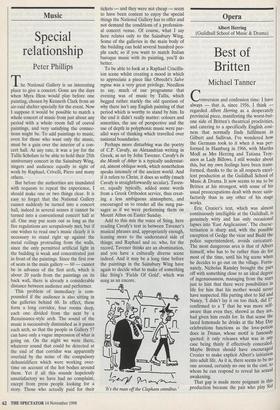Music
Special relationship
Peter Phillips
The National Gallery is an interesting place to give a concert. Gone are the days when Myra Hess would play before one painting, chosen by Kenneth Clark from an air-raid shelter specially for the event. Now I suppose it would be possible to match a whole concert of music from just about any period with a whole room full of coeval paintings, and very satisfying the connec- tions might be. To add paintings to music, even for those who want only the music, must be a gain over the interior of a con- cert hall. At any rate, it was a joy for the Tallis Scholars to be able to hold their 25th anniversary concert in the Sainsbury Wing, singers and audience equally in sight of work by Raphael, Crivelli, Piero and many others.
But before the authorities are inundated with requests to repeat the experience, I should make one or two things clear. It is easy to forget that the National Gallery cannot suddenly be turned into a concert hall, indeed in several senses it cannot be turned into a conventional concert hall at all. One may put seats out as long as the fire regulations are scrupulously met, but if one wishes to read one's music clearly it is necessary to stand right up against the metal railings protruding from the walls, since the only permitted artificial light in the building is weak and concentrated just in front of the paintings. Since the first row of seats in the main gallery — 60 — cannot be in advance of the first arch, which is about 20 yards from the paintings on its back wall, there is already a considerable distance between audience and performer.
This problem of immediacy is com- pounded if the audience is also sitting in the galleries behind 60. In effect, these form a long corridor, four rooms deep, each one divided from the next by a Renaissance-style arch. The sound of the music is successively diminished as it passes each arch, so that the people in Gallery 57 can have only a vague impression of what is going on. On the night we were there, whatever sound that could be detected at the end of that corridor was apparently overlaid by the noise of the compulsory dehumidifiers which were working over- time on account of the hot bodies around them. Yet if all this sounds hopelessly unsatisfactory we have had no complaint, except from press people looking for a story. Those who actually paid for their tickets — and they were not cheap — seem to have been content to enjoy the special things the National Gallery has to offer and not demand the conditions of a profession- al concert venue. Of course, what I say here relates only to the Sainsbury Wing. Some of the galleries in the main body of the building can hold several hundred peo- ple each; so if you want to match Italian baroque music with its painting, you'll do better.
To be able to look at a Raphael Crucifix- ion scene whilst creating a mood in which to appreciate a piece like Obrecht's Salve regina was a very great privilege. Needless to say, much of our programme that evening was of music by Tallis, which begged rather starkly the old question of why there isn't any English painting of that period which is worthy to stand by him. In the end it didn't really matter: colours and sonorities, the use of perspective and the use of depth in polyphonic music were par- allel ways of thinking which travelled over national boundaries.
Perhaps more disturbing was the poetry of C.P. Cavafy, an Alexandrian writing in Greek, as set by John Tavener. Cavafy's In the Month of Athyr is a typically understat- ed, almost oblique work, which nonetheless speaks intensely of the ancient world. And if it refers to Christ, it does so softly (much Cavafy is straightforwardly secular). Taven- er, equally typically, added some words from a Greek Orthodox service, thus creat- ing a less ambiguous atmosphere, and encouraged us to render all the sung pas- sages as if we were performing them on Mount Athos on Easter Sunday.
Add to this mix the voice of Sting, here reading Cavafy's text in between Tavener's musical phrases and, appropriately enough, leaning more to the understated side of things; and Raphael and co. who, for the record, Tavener thinks are an abomination, and you have a culturally diverse scene indeed. And it may be a long time before the paintings in the Sainsbury Wing have again to decide what to make of something like Sting's 'Fields Of Gold', which was sung as an encore.
It's the man off the Clapham omnibus.'


















































































 Previous page
Previous page